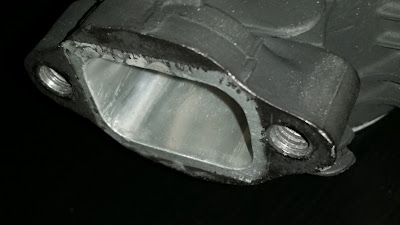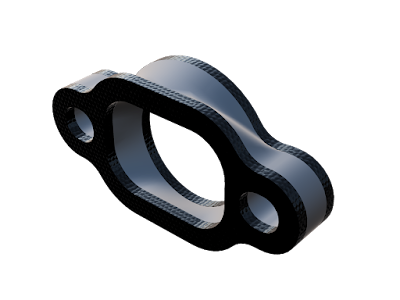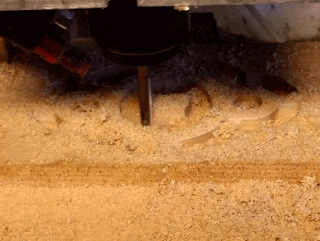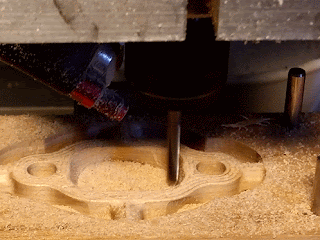Arguably one of the earlier mods people make to their mini moto / pocketbike, as soon as they're done installing the K&N type air filter is to put on a new pipe.
One hasn't got to look very far online to find a myriad of resellers all flogging pipes of various sizes, shapes and configurations and too, Ebay is loaded with them.
An unfortunate artifact of the vast majority of the pipes you'll encounter for sale is that they're basically stock pipes with a different shaped can or slight variations to the expansion chamber, but very very few will offer any real world difference in performance.
I'm going to focus this post on the Chinese type MiniMotos or 'Cags' for the moment as they're so plentiful, cheap, and have loads of potential if you purchase them with the view towards them being a learning experience and a project versus being a ready-to-run mini moto.
A quick bit of background: As my 8 year old son decided he desperately wanted to race MotoGP one day, the first logical step down that long, winding, and expensive road was the purchase of a mini moto to get him out on the track and get him used to the sensation of a powered 2-wheeled vehicle.
The option was there to simply purchase a Polini or Blata, but I wanted him to understand the bike, understand what happened when he twisted the throttle or squeezed the brake lever. I wanted him to intimately understand the workings of the bike as it would inevitably make him a better racer if he understood the mechanical side of what was going on under his backside.
With the parts being so plentiful and cheap, it seemed a logical step to pick up a 49cc air-cooled CAG and use that as a learning platform towards him being able to do his own work, maintenance and tuning. Quickly catching on, and catching an incurable case of the 'upgrades' bug, he soon started lusting after this component or that and it wasn't long before pipes caught his eye.
Several pipes later and a few semi official, and numerous unofficial dyno sessions later, I'll state that I've personally only found one aftermarket pipe which really delivers any serious performance on a CAG - the Zocchi pipe and can combination. With the usual mods (and a few extra tweaks here and there, this pipe/can combo will give you more mid-range and top end than anything else I've found for a CAG and will do so by an undeniable margin. I'm not referring to little gains or that 'tiny bit extra' .. I'm talking about a major increase in midrange torque and a fantastic top end. Were I to have to put a 'feel' to it, I'd suggest that the Zocchi combination is worth at least another 20-25% potentially beyond any other pipe I've yet seen. --conditionally.
The condition I'm referring to in the above is the gross mismatch between the typical shape of a massaged CAG exhaust port and the inlet for the Zocchi (and most other high-performance pipes). This is not at all unique to the Zocchi, but the rewards in addressing the issue were so richly rewarded by the Zocchi that it's worthy of specific mention.
Here's an image of a typical exhaust port on a CAG 'high performance cylinder' We've just started cleaning the port up, getting rid of casting flaws and doing a bit of reshaping, but you'll note that they're a distinctively rectangular port. This one, after an initial clean up was approximately 25.5 x 18mm.
 |
| Near stock exhaust port. |
Now, opened up and cleaned up properly, with a bit of reshaping of the port opening in the cylinder, you can actually get a quite reasonable flow out of these heads and this will make a dramatic improvement in the performance of the motor. Where this falls down quite badly however will be the moment you bolt a typical high-performance pipe to it.
Most aftermarket pipes (in fact, all 9 of the various ones I have here in the shop with me, all have round inlets, and all of them are between 18.5 and 22mm in diameter. The higher performance pipes all seem to be around 21ish so lets use that as a baseline.
I've mocked up quite carefully in cad, the exhaust port profile (as an average of the 4 cylinders I have here (none of them varied by more than 1mm in any dimension) and also the inlet profile for the Zocchi pipe (note, the effect I'm about to show is actually worse with every other pipe I have here).
If you simply bolt a high performance aftermarket pipe to a CAG head using an off the shelf gasket, even if the gasket has been portmatched to the exhaust port on the head, you have what's illustrated below:
 |
| Exhaust Port / Header Inlet Mismatch |
I've shown the surfaces I'm referring to in particular in red. This is the view looking down your exhaust port 'seeing' what the exhaust would encounter as it exits the head. The two read areas are not only closing off >20% of the effective port area, the turbulent air created by the exhaust flow encountering these obstructive walls effectively shrinks further, the cross section of the clean flow out of the port. This has a very negative effect on scavenging and on the entire function of the 2-stroke motor as a mechanism. There's such a delicate balance in these motors, as crude as they are in some ways, which allows for exhaust to exit, a fresh air/fuel charge to be brought into the cylinder, any extra air /fuel which escaped into the header is pushed back, then the compression and ignition, only to start the process all over again.
This small animated gif below is the best illustration I've ever seen of how things work in a 2-stroke engine:
 |
| The working of a 2-stroke engine. |
You can see clearly how critical it is to be able to evacuate the cylinder of the exhaust gasses and yet do so in such a way as to draw in the fresh air/fuel charge - but without letting it all escape into the exhaust.
*note: this is not my image, I found it. All credit to the original artist whom, if he will make him/herself known, I shall credit accordingly*
Of note, you can see from the animation that it's also important that the flow can travel backwards, into the cylinder in an unobstructed manner, so as to allow escaped air/fuel charge to be used. That return pressure wave effect which forces the unburned air/fuel charge back into the cylinder is the entire point of the expansion chamber on your pipe and it's dimensions are actually the result of a set of dedicated calculations based on a number of engine parameters.
Below is another CAD snapshot, this time showing what the return path would look like for the air/fuel charge being returned to the cylinder from the exhaust system - again, problem areas are in red.
 |
| Header / Exhaust Port Mismatch |
Again, the problem areas reduce the effective area by approximately 20% initially, but the effects of the turbulent flow over them has a greater impact.
For lack of a better way of demonstrating this, I did a bit of somewhat crude modelling in my Flow software, and showed an approximation of the behaviour of the exhaust flow from one side, and the unburned air/fuel charge from the other as they would flow across these two mismatches. I thought about trying to save them directly to video but in the interest of portability, I've simply used animated gifs made from captures of the Flow software.
Here you see the two flow models, one going in each direction. If you look carefully, you'll see that clean, unobstructed flow is only happening towards the centre 40% of the openings, whilst around the edges a boundary of turbulent 'air' is causing constriction beyond that of the obstructive walls which the flows are encountering.
 |
| Exhaust Flow From Head Towards Pipe |
 |
| Air/Fuel Charge Flow From Pipe Back Into Head |
Though these simulations aren't perfect, they're sufficient for the viewer to see the effect of the turbulence at the obstructive edges and their effects on flow. In particular, it's easy to see the flow being concentrated towards the centre of the opening with very little flow occurring at all in the outermost 25%. This has a similar effect to fitting an exhaust restrictor by reducing the effective diameter through which the flow is able to pass at proper velocity.
When time allows, I'll whip up some more elaborate simulations, complete with numbers and pre/post transition flow in both directions. I do think though that the turbulence and its' effects are quite easy to see here.
Without some modification, there's not a whole lot which can be done about this. No amount of massaging on the head is going to do much to rid you of the square port/round pipe problem, Alternatively after sinking good money into a proper pipe, the last thing you'll want to do is take a torch to it.
Initially, I'd looked at what could be done easily by the average home user and explored the options for using compounds such as liquid metal, JB Weld and others which offer a (mostly) room temperature cure whilst yielding a machinable metal-like result.
Something these compounds will not do, however, is take the heat of being in the exhaust port for very long. They might briefly, but they'll soon dislodge and end up in your pipe or perhaps fragmenting and bits being sucked back into your engine with all the to-be-expected, catastrophic results.
The ideal solution might be to have the corners of the port built up with aluminium welding and then reshape the port from scratch, and indeed, this would likely give ultimately the best result under ideal conditions. The two local welding shops I spoke to both wanted roughly £100 per head to perform the welding which seemed very high. I'm sure the work could be had cheaper, but even were it so, you'd still be stuck with completely reshaping the port from scratch.
Looking further towards a solutions which might be more bolt on, I designed in CAD a 'transition' piece which has smooth contoured flow between the two shapes of the port and pipe. Though a longer transition might be gentler, it would also affect the carefully calibrated pipe on which you've just spent so much money (and yes, 10 mm here and there DO matter) so with this in mind, I've made the piece 6mm long and quite carefully shaped the transition to minimise the flow disruption. This isn't a simple 'loft' between the two shapes, though it started that way. A bit of tuning and tweaking to the transition yielded some worthwhile results.
I'd personally suggest removing 2.5-3mm of metal from the face of the port. That will still leave plenty of meat for the bolts to anchor in to, but will serve to alleviate the effects of the nearly 10mm total (assuming 2mm thick exhaust gaskets on each side) of the transition piece. I don't recommend taking any material off the pipe
The transition piece looks much like the image below. This one is one version back from the current one which has now been flow tested, real world tested and is quite close to being a completely finished, tested product. At this point, I can confidently say that there's a consistent gain of at LEAST 17% over the standard configuration and with a couple of pipes, the difference is over 20%
 |
| Exhaust Flow Transition Piece V3 |
When fitted, these adapters greatly smooth and improve the flow between the two cross sections, whilst taking up a minimum of depth.
I'm in the process now of exploring casting options as cast in quantity, these could be very economical indeed whilst offering the performance gains which I'm seeing from the prototypes.
They'll come with a pair of exhaust gaskets, one matching the openings on each side and with their use, I recommend using longer bolts with washers and stiff springs to attach the pipe to the head. This configuration has yielded the best results so far in testing and once I changed to this method of attachment, the issues with short gasket life were instantly eliminated. At this point, I attribute the gasket issues to expansion and contraction of the transition piece between the head and pipe and as such, spring loading the joint served to resolve the issue immediately. I may look towards creating a bit of a package with the transition piece, the two appropriate gaskets, and the necessary bolts or studs, washers, springs..etc for attachment if there's sufficient demand. So far, I've 11 pre-orders which took me somewhat by surprise. I'm going to make these kits available soon to anyone who's interested.
Here are two more animations of simulation results, this time with the transition piece in place. The difference in the behaviour of the flows towards the outside 30% of each cross section is immediately apparent and is making a real difference in the overall flow volume.
 |
| Improved Flow From Port To Pipe Using Transition Piece |
 |
| Improved Flow From Pipe Back To Port Using Transition Piece |
I'm quite happy with these results, especially from a piece which will be small, easy to install, and straightforward to manufacture. Though a slight massaging for exact port matching will benefit some applications, the vast majority of potential users will be able to bolt these in place, as is, and see immediate, significant improvement in performance.
As a closing note, just to reaffirm what I've put forward in my CAD images, below are two images, one of a standard CAG exhaust gasket sitting against a largely stock port, and a 2nd of this gasket sitting on the flange of a high-performance pipe - it really is a very undesirable mismatch.
 |
| Exhaust Gasket On A Stock Head |
 |
| Exhaust Gasket On A High Performance Pipe |
































